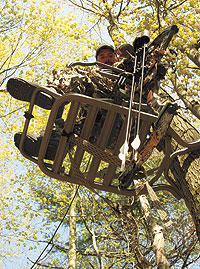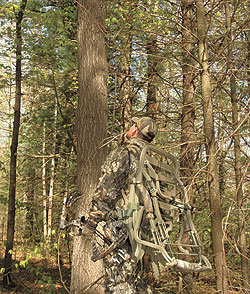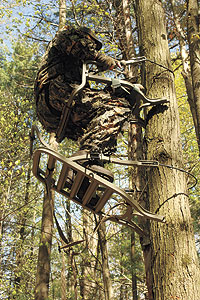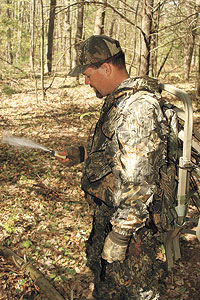October 28, 2010
By Tracy Breen
Get Ready To Be Deadly Versatile This Season
By Tracy Breen
Anyone who has ever used a climbing tree stand can tell you at least one story about a close call they had climbing up or down a tree. Most accidents happen when hunters are using old and outdated equipment or when they don't understand how to operate a climbing stand properly. I have heard several hunters say that they won't use a climbing stand because they are afraid of having an accident. The truth is, climbers have been popular in the South for years, yet by refusing to use a climbing tree stand, other hunters are walking away from one of the greatest tools available to harvest game. Today's climbing tree stands are easy to use, lightweight and provide hunters with more versatility than any other type of stand.
Old-School Stands
Thirty years ago, many climbing style stands were heavy, cumbersome, and hard to figure out. In order to use one, hunters had to be in excellent physical shape. If they weren't, by the time they got 20 feet in the tree they were ready to have a heart attack. Hunters who used these prototypes recognized the advantage they had when using a climbing stand and were willing to take the hassles associated with them in order to maximize their opportunities of bagging a trophy. The early style climbers had a few problems, one of the biggest was that if hunters changed their angle ever so slightly as they climbed a tree, the stand would come loose and start to slide down the trunk. This often resulted in hunters hanging in a tree with the top half of the climber. I have heard more than one story about hunters who were left hanging who had to hug the tree in an attempt to make a slow decent.
Advertisement
In the last decade or two, stand companies have made many improvements to climbers. For instance, early climbers relied heavily on a knife blade to stay in the tree. The blade on the climber, which dug into the tree and kept a hunter secure, was only hanging on by the bark of the tree; the blade was designed to dig into the bark. If hunters were climbing a tree with loose bark or a tree like a pine that doesn't have strong bark to begin with, they stood a good chance of coming loose. The potential for an accident loomed.
Climbers of yesteryear created a lot of noise as hunters went up the tree. As the blade dug into the tree, it created enough noise that any deer within one half-mile would hear it and head in the opposite direction. In addition to creating a lot of noise from ripping tree bark up on the way up, the climbers themselves were incredibly noisy. After hearing the bark being ripped up, a bang or clang was sure to follow from the squeaky stand. Much of the noise created was because the stand was put together with nuts and bolts, which get loud and can come apart, creating a noisy and dangerous situation.
Advertisement
 Climbing tree stands have come a long ways in the last decade. Manufacturers have addressed noise, safety and comfort concerns with some very beneficial results for archery hunters. |
When all of those components are added together, you get a complete package that many hunters steered clear of because they didn't trust a climbing contraption or because they tried to use one but hadn't had the proper training or practice.
Modern Climbers
Technology has changed every industry in the last few decades, including the archery industry. They say necessity is the mother of all inventions, and manufacturers knew climbing stands could be made safer and quieter. Many of them set out to make a stand that was better all around. Older stands were often made of shiny metal, but today's models are typically olive green or some other drab color that blends in perfectly in the woods.
Early climbers were often uncomfortable because their seats were nothing more than plywood or metal which made sitting in a stand for long periods of time a daunting task. Today, almost all climbers have padded seats so hunters can stay in the woods for the long haul. Early climbers were heavy and cumbersome. Climbers are now made out of aluminum, which makes for a light stand that can hold a lot of weight. In 1981, John Woller, the founder of Summit Treestands, set out to make a better climber that was safer, quieter, and more comfortable than its predecessors.
He added a padded seat to his very first model and Summit was the first company to offer padded seats. His first stands were made of all-welded construction. The result was a stand that was comfortable to sit in for long periods of time and a stand that could be used to climb a tree quickly and easily that was quiet and sturdy. Climbers no longer have bolts or rivets and regardless of the brand, they are now strong, sturdy climbing machines.
One pet peeve of many hunters in the early days of climbers was that the stands made noise as soon as hunters moved to take a shot. As the stands got older, the nuts and bolts would make noise. All-welded construction solved that problem. In addition to having all-welded construction, climbers no longer rely completely on the teeth to grip the tree. According to Woller, basic engineering concepts are used instead of a giant knife blade. Woller has an engineering background and has used geometry and engineering know-how to create a stand that is safe and quiet. Regardless of what kind of tree hunters are hunting from, a climber can safely climb it.
The first climbers were hand climbers. Many hunters did not like them because they required a lot of work to climb a tree. Now we have stand up/sit down models that even the weakest hunters can operate. Hunters don't have to be "Arnold" to climb into a tree. They simply need to stand up and sit down over and over again until they reach their desired level in the tree. These types of climbers are very quiet. If the only thing hunters remember from using a climber is being tired when they were done climbing a tree, it is time to try a stand up/sit down climber.
 The perfect tree is no longer necessary to hang a climber. Designs have evolved over the years to allow archers to level off stands while set up, and to accommodate hunters when the best tree they can find is not perfectly straight. |
Climbers now come with a sissy bar across the front of the stand that hunters can lean into as they take a shot to steady themselves. It protects hunters from falling off the front of the stand.
Another problem with
early climbers was as hunters climbed and the tree tapered, the climber would end up not being level when hunters reached their desired height. Although that can still happen, many modern day climbers offer a cable system that secures the stand to the tree. They can be slightly adjusted from shooting height so hunters can make their platform as level as possible. Some stands even have a built in level so they know if they are level or not as they climb. In the old days, if a stand wasn't level, hunters had to climb down the tree, readjust and start the climb all over. The same cable that can be adjusted at shooting height is easily adjusted at ground level. Not all trees can accommodate a climber, but most modern day climbers can work on a wide variety of trees because of the easily adjustable cable.
Go Versatile
Once hunters understand how a climber works and they are confident in their climbing ability, they can hunt more places than they ever thought possible. Bob Ransom of Ameristep says one of the reasons he enjoys using climbers is because they make hunters so versatile. "In a matter of minutes, I can be in a tree hunting.
Most of the time, I can hunt at whatever height I want to. If I don't see any deer today, I can quickly come down from the tree and head to a new area the next day," Ransom said. John Woller thinks there is no better method to hunt from than a climber. "If the wind direction changes when I reach my hunting spot, I can move to a different area and hunt. If I find a fresh scrape today, I can be hunting over it today. With a climber, you can change and adapt your hunting style as quickly as you need to in order to adjust to what the deer are doing," Woller explained.
Since climbers provide so much versatility for archery hunters, they have become extremely popular over the years. Although climbers are often thought of as a stand that is made for guys who are fit and trim, today's climbers are so easy to use, hunters of all ages can use them. "A lot of older hunters are now using other styles of stands because they think climbers are hard to use. But climbers today are easy to use and even older archers can climb a tree with a climber," Woller explained.
Stand up/sit down climbers are by far the most popular style for older hunters for several reasons. Anyone can stand up and sit down and they glide up a tree with very little effort. If you are somewhat out of shape, you can take smaller steps and take a break between climbs if you get tired. When you add all of the features that are available today to make them easy to use, it becomes clear why every hunter should have a climbing tree stand in their closet.
 The stand up/sit down method of climbing has made it easy for just about any archer regardless of physical condition, to utilize a climbing stand safely and easily. |
Due to the fact that they are lighter than they were a couple decades ago, almost any hunter who can carry 20 pounds on his back can use a stand up/sit down style of climber. If you want something even lighter, some hand climbers weigh less than 15 pounds. Although climbers only weigh about 15 to 20 pounds, most of them can handle hunters who weigh up to 300 pounds or even more. Some of them can handle hunters who weigh up to 350 pounds.
Tree stand manufacturers have taken climbers to the next level by offering other features that make them extremely user-friendly. For instance, some stands have brackets built on the stand for hunters' feet to slide into, eliminating the need for foot straps as they climb. They come with a footrest; relaxing 20 feet in a tree has never been easier.
The stands are even sturdier once in the tree than they ever have been, thanks to quality engineering. For instance, the Non-Typical Stinger has pivoting arms that lock to the tree, making it extremely secure once your stand is in position. Almost all climbers come with a safety strap system that holds the top and bottom sections of the climber together to ensure the bottom doesn't slip and fall to the ground leaving you hanging 20 feet in the tree. Most climbers fold up nicely after you are done hunting, making transporting them in and out of the woods a piece of cake.
 The days of fearing loud, cumbersome and in some situations dangerous climbing stands are gone. Today's models are light years beyond their predecessors and have become an invaluable tool to archers looking for a versatility edge in their hunting pursuits. |
Most climbers come with a four-point fall restraint device that hunters can wear while climbing up and down the tree to catch them if they fall. Although hunters may consider wearing a safety system a pain, studies indicate that they add less than a couple minutes to the overall climb time. To ensure you truly are safe while using any tree stand, make sure to wear a fall restraint device.
Now that you have read how far climbers have come in the last few decades, maybe it is time you pick one up. Is there a buck making scrapes on a distant ridge? Did you recently discover a rub line a mile off the road? Did the wind suddenly change directions on you? With a climber you can hunt almost anywhere at the drop of a hat, which could mean the difference between going home empty handed or going home with a success story!
